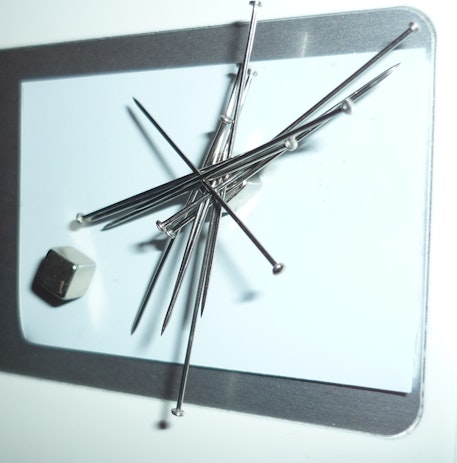
An Organised Sewing Table
A well organised sewing table makes for easier working
Online since: 27/05/2008,
Number of visits: 399249
0
Table of Contents
Just glue a piece of metal tape
discreetly onto the sewing machine.
Then attach a few small cube magnets W-05-N
to the tape; now your pins and needles adhere nicely to the machine and don't fall to the floor.
Magnetic needle plate
Pins and sewing needles can also be stored next to the sewing machine to have them handy. Here's another magnetic idea: Glue a self-adhesive disc magnet, for example one S-10-01-STIC, onto a small plate and press on well. And there you have a magnetic pin plate!Alternatively, you can of course also purchase a small magnetic bowl.
Collecting safety pins
A sphere magnet such as K-08-C is a good solution for storing safety pins, which arrange themselves radially around the magnet.Attachment on an antique sewing machine
Very old sewing machines (here a Pfaff) are magnetic, which is very helpful: Small metal pieces, which sometimes need to be removed from the machine (also needles), can be directly attached to the machine itself with little magnets. You always have the pieces in view and they can't get lost somewhere in the depths of a drawer.Attachment to the table top
A sewing machine also needs an original Pfaff wooden table top.Neodymium magnets are really practical for organizing my working space without drilling dozens of unnecessary holes in the wood.
The ruler, tweezers and screwdriver all hang on the iron bracket under the table.
A different pincushion
Addition from customer Christian Horn from Engelskirchen (Germany):
The mother of my girlfriend ran into a problem with her handsewn pincushions: The needles kept disappearing in the cushion.
To replace her dangerous cushion, I made a wooden pin hedgehog for her.
The advantages of the hedgehog: The needles appear to be disorganised but they are always visible and can be removed individually.
The structure consists of a hedgehog body made of 9 mm thick beech plywood.
I drilled 7,5-8 mm and approx.
4,5-5 mm deep holes into the back of the hedgehog.
Then I pressed three disc magnets S-08-05-N
into the holes.
The magnets stay in place even without adhesive.
In the end, I "painted" them with a soldering iron.
It is important that the magnets don't get hotter than 80° C, otherwise, they'll lose their magnetisation.
The entire content of this site is protected by copyright.
Copying the content or using it elsewhere is not permitted without explicit approval.
Copying the content or using it elsewhere is not permitted without explicit approval.






















